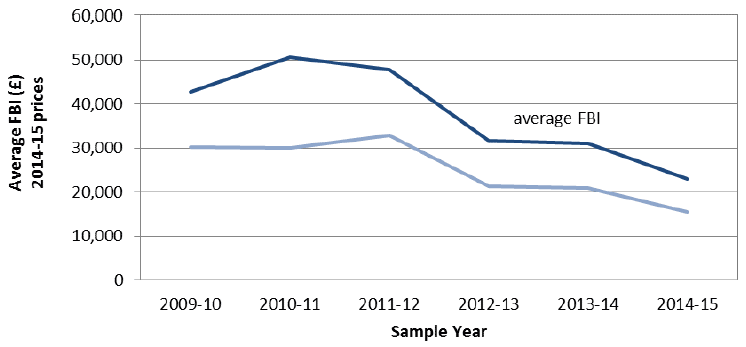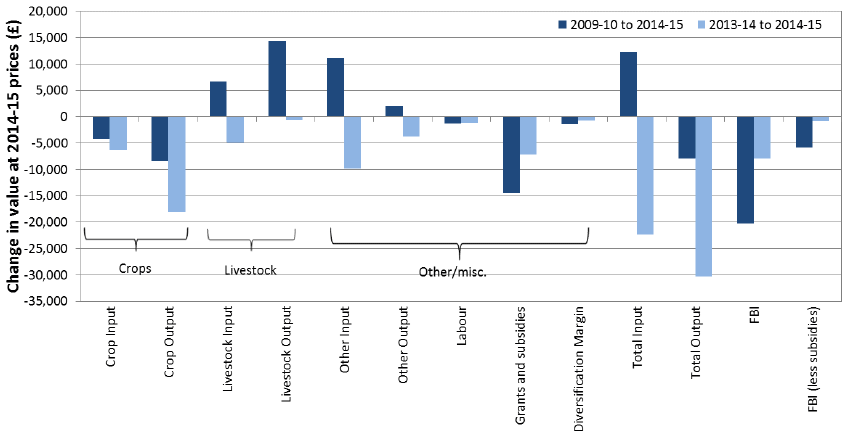Economic Report on Scottish Agriculture, 2016
Presents an overall picture of Scottish agriculture using data from the various agricultural surveys that RESAS manage.
3.2 Farm Business Income ( FBI) (Table B2)
Farm Business Income ( FBI) is the average headline business-level measure of farm income in the UK. FBI represents the return to the whole farm business, that is, the total income available to all unpaid labour and their capital invested in the business. Returns from diversified activities (non-agricultural activities that use farm resources, for example: renting out farm cottages for tourism; income from small-medium scale wind turbines; etc.) are included in overall FBI (as they are in TIFF), though not larger-scale enterprises that count as separate businesses.
In Scotland, the data used to calculate FBI comes from the Farm Accounts Survey ( FAS). The FAS represents economically active farms (using at least half the average labour requirement of a crop or livestock enterprise - see SLR definition in section 7.3). The FAS therefore excludes many small holdings. Horticulture, pigs and poultry farms are also excluded, whereas, since TIFF uses national data, it includes all farm types.
Scottish FBI figures for farms, classified into types by standard outputs (see section 2.5), are available from 2009-10, up to the latest year available of 2014-15, based on the 2014 crop year. Unless stated otherwise, time series are presented in 2014-15 prices, using the GDP (Gross Domestic Product) deflator index. This provides more reliable trends as the effects of inflation are accounted for. The Net Farm Income measure provides a longer time series and is presented by farm type in section 3.12. The difference between FBI and NFI is explained in the FAS methodology and quality note, along with other information on the survey methodology and quality of results, on the agriculture statistics web page [5] . More detailed data tables are also available in the 2014‑15 FAS data tables [6] , also on the agriculture statistics web page.
Chart 3.3 below shows that in 2014-15, the average Farm Business Income ( FBI) was £23,000, the lowest level in the last six years. This is 26 per cent lower than the previous year; down (£8,000) and down 46 per cent since 2009-10. Average incomes were highest in 2010-11, at £51,000, largely due to lower input costs.
Chart 3.3: Average FBI of Scottish farms, 2009-10 to 2014-15

The average FBI has been in decline since then, though in 2013-14 the average FBI of Scottish farms was relatively unchanged (fall of £600) at £31,000, compared to 2012-13. Over the longer term, rising input costs for livestock, such as feed, as well as costs for machinery, land and buildings have lowered the average FBI.
Chart 3.4 shows a breakdown of factors affecting changes in FBI over the six year series in comparison to the changes in the latest year. This shows that all revenues and spending fell over the last year. Crop revenues saw larger reductions than spending on inputs, putting a downward pressure on margins from cropping enterprises. Livestock production costs fell, considerably more than the revenues, with the opposite effect for such enterprises. The value of subsidy payments also fell. Overall, revenues saw greater reductions than spending on inputs, resulting in a fall in income. Had the level of subsidy payments remained unchanged, the overall average FBI would have fallen by only £800. However, it is the decline in crop revenue which has contributed the most to the decline in profitability of Scottish farm businesses in 2014-15.
Chart 3.4: 2014-15 Changes to FBI components: all farm types

Source: online FAS data tables
Amongst farms in the Farm Accounts Survey, the average value of Single Farm Payment subsidy fell by around £7,000 to an average of £31,000 per farm in 2014‑15. This was largely due to unfavourable exchange rates as well as a reduction in the original Euro amount.
Over the longer term, while revenues for livestock have improved, these have been outweighed by a rise in spending on inputs (in particular "other" costs such as: machinery; land and buildings; depreciation; and miscellaneous costs) combined with a declining average value of subsidy payments. Labour costs are largely unchanged when compared over six years, having fallen by around £1,000.
Contact
There is a problem
Thanks for your feedback